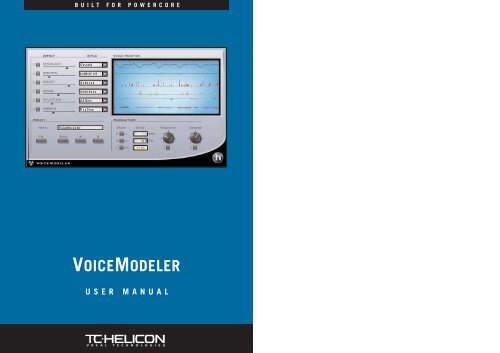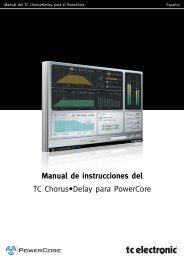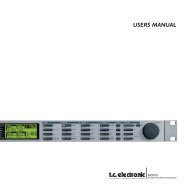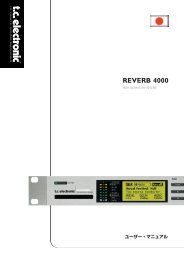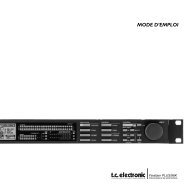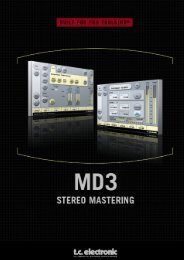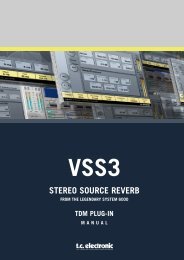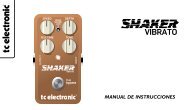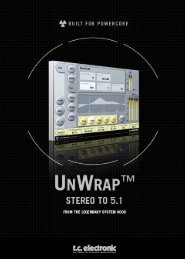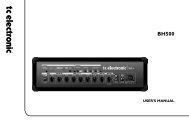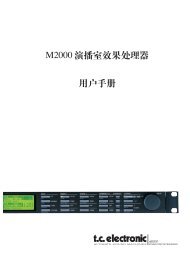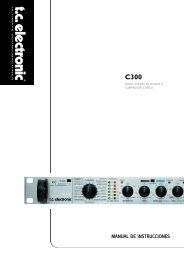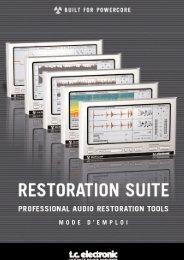VoiceModeler PowerCore Manual English - TC Electronic
VoiceModeler PowerCore Manual English - TC Electronic
VoiceModeler PowerCore Manual English - TC Electronic
Create successful ePaper yourself
Turn your PDF publications into a flip-book with our unique Google optimized e-Paper software.
BUILT FOR POWERCORE<br />
VOICEMODELER<br />
USER MANUAL
CONTACT DETAILS<br />
If you would like to get in touch with us please e-mail to: support@tcelectronic.com,<br />
contact our local distribution partner or write to:<br />
<strong>TC</strong> ELECTRONIC A/S<br />
Customer Support<br />
Sindalsvej 34<br />
Risskov DK-8240<br />
Denmark<br />
www.tcelectronic.com<br />
e-mail: support@tcelectronic.com<br />
USA:<br />
<strong>TC</strong> <strong>Electronic</strong> Inc.<br />
<strong>TC</strong> Works Customer Support<br />
742-A Hampshire Rd.<br />
Westlake Village, CA 91361<br />
Phone: 805-373-1828<br />
TABLE OF CONTENTS<br />
INTRODUCTION<br />
SYSTEM REQUIREMENTS . . . . . . . . . . . . . . . . . . . . . . . . . . . . . . . . . . . . . . . . . 1<br />
WINDOWS . . . . . . . . . . . . . . . . . . . . . . . . . . . . . . . . . . . . . . . . . . . . 1<br />
MAC OS X . . . . . . . . . . . . . . . . . . . . . . . . . . . . . . . . . . . . . . . . . . . . 1<br />
VOICEMODELER - OVERVIEW . . . . . . . . . . . . . . . . . . . . . . . . . . . . . . . . . . . . . . 2<br />
USING THE VOICEMODELER EFFECTS SECTION . . . . . . . . . . . . . . . . . . . . . . . . . 4<br />
EFFECT PARAMETERS . . . . . . . . . . . . . . . . . . . . . . . . . . . . . . . . . . . . . . . . . . . 4<br />
RESONANCE . . . . . . . . . . . . . . . . . . . . . . . . . . . . . . . . . . . . . . . . . . 4<br />
SPECTRAL . . . . . . . . . . . . . . . . . . . . . . . . . . . . . . . . . . . . . . . . . . . . 4<br />
BREATH . . . . . . . . . . . . . . . . . . . . . . . . . . . . . . . . . . . . . . . . . . . . . 4<br />
GROWL . . . . . . . . . . . . . . . . . . . . . . . . . . . . . . . . . . . . . . . . . . . . . . 4<br />
INFLECTION . . . . . . . . . . . . . . . . . . . . . . . . . . . . . . . . . . . . . . . . . . 5<br />
VIBRATO . . . . . . . . . . . . . . . . . . . . . . . . . . . . . . . . . . . . . . . . . . . . . 5<br />
USING MODULATION . . . . . . . . . . . . . . . . . . . . . . . . . . . . . . . . . . . . . . . . . . . . 6<br />
SHAPE . . . . . . . . . . . . . . . . . . . . . . . . . . . . . . . . . . . . . . . . . . . . . . 6<br />
SYNC . . . . . . . . . . . . . . . . . . . . . . . . . . . . . . . . . . . . . . . . . . . . . . . 6<br />
BPM . . . . . . . . . . . . . . . . . . . . . . . . . . . . . . . . . . . . . . . . . . . . . . . 6<br />
DIV . . . . . . . . . . . . . . . . . . . . . . . . . . . . . . . . . . . . . . . . . . . . . . . 6<br />
RESONANCE AND SPECTRAL MODULATION SETTINGS . . . . . . . . . . . . 6<br />
THE VOICE MODELER DISPLAY . . . . . . . . . . . . . . . . . . . . . . . . . . . . . 7<br />
PRESET MANAGEMENT . . . . . . . . . . . . . . . . . . . . . . . . . . . . . . . . . . . . . . . . . . 7<br />
STYLES . . . . . . . . . . . . . . . . . . . . . . . . . . . . . . . . . . . . . . . . . . . . . . 7<br />
PRESETS . . . . . . . . . . . . . . . . . . . . . . . . . . . . . . . . . . . . . . . . . . . . . 7<br />
TECHNICAL SUPPORT<br />
For immediate answers on many support questions,<br />
visit the <strong>TC</strong> SUPPORT INTERACTIVE pages on<br />
www.tc-helicon.tc or www.tcelectronic.com<br />
PRESET COMMANDS . . . . . . . . . . . . . . . . . . . . . . . . . . . . . . . . . . . . . . . . . . . . 8<br />
THE PRESET FILE MENU . . . . . . . . . . . . . . . . . . . . . . . . . . . . . . . . . 8<br />
LOAD PRESET . . . . . . . . . . . . . . . . . . . . . . . . . . . . . . . . . . . . . . . . . 8<br />
SAVE PRESET . . . . . . . . . . . . . . . . . . . . . . . . . . . . . . . . . . . . . . . . . 8<br />
A/B PRESET COMPARISON . . . . . . . . . . . . . . . . . . . . . . . . . . . . . . . . 8<br />
DEFAULT PRESET LOCATIONS: . . . . . . . . . . . . . . . . . . . . . . . . . . . . . . . . . . . . . 9<br />
MAC OS X . . . . . . . . . . . . . . . . . . . . . . . . . . . . . . . . . . . . . . . . . . . . 9<br />
MAC OS X ADMINISTRATOR PRIVELEGES . . . . . . . . . . . . . . . . . . 9<br />
WINDOWS . . . . . . . . . . . . . . . . . . . . . . . . . . . . . . . . . . . . . . . . . . . . 9<br />
USING VOICEMODELER IN MAC OS X . . . . . . . . . . . . . . . . . . . . . . . . . . . . . . . . 9<br />
PLUG-IN FORMATS . . . . . . . . . . . . . . . . . . . . . . . . . . . . . . . . . . . . . . 9<br />
AUDIO UNIT COMPONENTS . . . . . . . . . . . . . . . . . . . . . . . . . . . . . . . . 9<br />
Appendix1: APPLICABLE PATENTS FOR HYBRID SHIFTING . . . . . . . . . . . . . . . . 11<br />
E N G L I S H<br />
E N G L I S H
INTRODUCTION<br />
Thank you for purchasing the <strong>TC</strong>-Helicon <strong>VoiceModeler</strong>® Vocal Modeling Tool for<br />
POWERCORE. Now POWERCORE users can craft unique voices with <strong>TC</strong>-Helicon’s<br />
innovative voice modeling tools. Now you are no longer limited to EQ and Pitch – with<br />
this Plug-In you can dramatically alter the sound of any voice! Change the sound of<br />
any vocal from “thin” to “throaty” – or even “male” to “female”.<br />
By adjusting <strong>VoiceModeler</strong> Spectral and Resonance, you can alter the voice completely.<br />
Add to this the Inflection and Vibrato controls, changing the quality and expression<br />
of a performance, and you get an idea of how powerful this is! Enhance the vocal<br />
sound by adding “crispness” or more “breath”. Dull performances will instantly<br />
breathe with new life when you apply <strong>VoiceModeler</strong>. Growl adds additional control over<br />
the performance – many of the parameters are dynamically controlled by the incoming<br />
audio, ensuring a natural sound. Even if you are limited to only one voice in real life,<br />
with <strong>VoiceModeler</strong> you can have multiple “Voice Personalities”. Build a choir featuring<br />
different voices – all built from one “source sound”. There is no limit to the creative<br />
possibilities of <strong>VoiceModeler</strong> – if you are bored with cliché pitch-effects and Vocoders,<br />
prepare for a revelation. Don’t be fooled by the easy interface – the sonic possibilities<br />
are deep. Abuse the Plug-In to go where no one has gone before – and enjoy the<br />
results! Working with <strong>VoiceModeler</strong> gives you instant results – it’s all realtime and easy<br />
to use with a bank of carefully selected presets that will sound new every time you try<br />
a different voice!<br />
SYSTEM REQUIREMENTS<br />
WINDOWS<br />
• POWERCORE PCI or FW running system 1.7 or later<br />
• Windows 2000 or XP<br />
• PIII 500 or faster<br />
• 256 MB RAM<br />
• VST compatible host application<br />
• System must meet requirements of the host application and POWERCORE<br />
MAC OS X<br />
• POWERCORE PCI or FW running system 1.7 or later<br />
• Mac OS X (10.2.3 or higher)<br />
• G3/300 or faster (G4 Recommended)<br />
• 256 MB RAM<br />
• VST or Audio Units compatible host application*<br />
• System must meet requirements of the host application and POWERCORE<br />
*At the time this manual was created, support for MOTU’s Digital Performer is only<br />
possible by using Apple’s Audio Units Plug-In format.<br />
The <strong>TC</strong>-Helicon Team<br />
www.tc-helicon.com<br />
ATTENTION!<br />
THIS IS A POWERCORE PLUG-IN AND REQUIRES AT LEAST ONE POW-<br />
ERCORE TO BE INSTALLED ON YOUR SYSTEM! THIS PLUG-IN WILL<br />
NOT RUN WITHOUT POWERCORE.<br />
E N G L I S H<br />
NOTE: The <strong>TC</strong>-Helicon <strong>VoiceModeler</strong>® requires POWERCORE software 1.7 or<br />
higher.<br />
NOTE: Due to the nature of the <strong>TC</strong>-Helicon <strong>VoiceModeler</strong>® algorithm, NO LATENCY<br />
MODE is not supported for this plug-in.<br />
is a <strong>TC</strong> Group company.<br />
© by <strong>TC</strong>-Helicon & <strong>TC</strong> Works 2003. All product and company names are trademarks of their respective owners.<br />
All specifications subject to change without notice. All rights reserved.<br />
E N G L I S H<br />
VOICEMODELER / 1
VOICEMODELER<br />
OVERVIEW<br />
2<br />
3<br />
1 5<br />
4<br />
7<br />
6<br />
E N G L I S H<br />
1. Effect Bypass<br />
2. Effect Amount<br />
3. Style Section<br />
4. Preset & Comparison Section<br />
5. Metering & Voice Monitor Section<br />
6. Modulation Section<br />
7. Modulation Bypass<br />
E N G L I S H<br />
2/ VOICEMODELER VOICEMODELER / 3
USING THE VOICEMODELER EFFECTS SECTION<br />
EFFECT PARAMETERS<br />
The EFFECT section of <strong>VoiceModeler</strong> is where<br />
your select the effect style and the amount.<br />
To bypass an effect, click on the BYPASS button<br />
to the left of the effect name. When lit, the<br />
effect is active.<br />
To increase or decrease the amount of effect<br />
applied to your signal, move the EFFECT<br />
SLIDER or double click to enter an amount, in<br />
percentage.<br />
To select a new STYLE, use the drop-down<br />
menu. When a list of available styles appears,<br />
select one with the mouse to activate it.<br />
RESONANCE<br />
The RESONANCE control allows you to take the harmonic content that forms the<br />
identity of the incoming voice and change the content’s positioning to yield a new<br />
character to the sound. Some styles change the voice to a heavier, darker chest<br />
resonance, while others lighten the sound to more of a head and throat resonance.<br />
Some styles also change the voice in a more complex way that depends on the input<br />
voice.<br />
Note: The amount of modulation applicable to RESONANCE depends on the style.<br />
characteristics. Some styles are sensitive to the dynamics of the incoming vocal,<br />
meaning that the effect can be controlled by the volume of what is sung into<br />
<strong>VoiceModeler</strong>.<br />
INFLECTION<br />
The INFLECTION control can alter the inflection of your vocals in different ways. As<br />
one example, you can add various types of “scooping” effects to the onsets of a lead<br />
vocal. INFLECTION is also the place where you can find the humanization tools that<br />
will help you give a harmony line its own identity or create extremely natural doubling<br />
effect. Inflection provides tools such as portamento, pitch and timing randomization<br />
as well as up/down scoop models.<br />
VIBRATO<br />
VIBRATO controls the pitch and amplitude effect that singers often use in their delivery<br />
of a piece of music. It is a combination of various characteristics of the voice<br />
being repeatedly altered in a oscillating fashion. Every singer’s vibrato is unique. The<br />
Vibrato Styles are based on real vocalist’s vibratos. We have analyzed a large range of<br />
parameters from a voice database and created various vibrato models. The Vibrato setting<br />
names reflect the style of the vocals from which they were extracted.<br />
Experimentation is the key to finding a style setting that best suits your application.<br />
You might begin incorporating Vibrato into your sound by setting the VIBRATO amount<br />
control to 50%. This setting matches the depth level that we analyzed in our modeling<br />
subjects. VIBRATO can be controlled by the volume of the <strong>VoiceModeler</strong> input.<br />
Note: VIBRATO relies heavily on the input signal and cannot be synced to MIDI.<br />
E N G L I S H<br />
SPECTRAL<br />
The SPECTRAL control is a set of specially modeled equalizer response curves which<br />
reflect the natural equalization equivalent to the native control a singer has over his or<br />
her own voice.<br />
Note: The amount of modulation applicable to SPECTRAL depends on the style.<br />
BREATH<br />
The BREATH control adds breathiness to the vocal. This can vary from a whisper, all<br />
the way to a rough, raspy sound, such as is found in hard rock and ‘alternative’ rock<br />
music. Some styles are sensitive to the dynamics of the incoming vocal, meaning that<br />
they can be ‘played’ by varying the level of what is sung into <strong>VoiceModeler</strong>.<br />
GROWL<br />
The GROWL control in <strong>VoiceModeler</strong> mimics the friction activity between the larynx<br />
and epiglottis regions of the vocal tract. This is a ‘character’ phenomenon used in<br />
high energy rock, blues or old soul music. The GROWL effect also models the<br />
changes in the vocal tract shape that growling requires, altering the vocal resonance<br />
E N G L I S H<br />
4/ VOICEMODELER VOICEMODELER / 5
USING MODULATION<br />
The <strong>VoiceModeler</strong> features a<br />
MODULATION section that can modulate<br />
both the Resonance effect and the<br />
Spectral effect, and each can modulated<br />
with different amounts! Additionally, modulation<br />
can be synchronized to MIDI, if you<br />
host application supports this.<br />
Note: Modulation is usually quite subtle. Some styles have more modulation possibilities<br />
than others, depending on the style used for the Resonance and Spectral effect<br />
parameters.<br />
The <strong>VoiceModeler</strong> Display<br />
<strong>VoiceModeler</strong> divides the display into lanes, allowing you to see how much of an effect is<br />
active as well as when it is active. The greater the effect amount used, the more<br />
active that parameter lane will become in the display. Bypassing the parameter or setting<br />
the effect amount to zero will result in an inactive display for that parameter.<br />
SHAPE<br />
Sine<br />
Triangle<br />
Random (Sample and Hold)<br />
The SHAPE parameter determines the wave<br />
shape of the LFO. To select the SHAPE, click<br />
on the shape button next to the wave form you<br />
wish to use.<br />
SYNC<br />
The SYNC parameter allows you to synchronize the speed to incoming MIDI clock in<br />
musically relevant values such as “1 bar”, which would result in one full LFO cycle<br />
taking exactly 1 bar. Click on SYNC to activate MIDI synchronization. When activated,<br />
the SYNC indicator will light up.<br />
The functionality of this parameter requires that your host application can provide the clock<br />
information to the Plug-In.<br />
BPM<br />
This sets the speed of the LFO, in BPM (Beats Per Minute). BPM is closely related to<br />
the beat division (DIV).<br />
PRESET MANAGEMENT<br />
STYLES<br />
Each <strong>VoiceModeler</strong> effect can load a STYLE, which has been created by<br />
<strong>TC</strong>-Helicon to cover a range of uses; from the subtle to the extreme.<br />
A <strong>VoiceModeler</strong> STYLE cannot be edited, but they are incorporated into your<br />
presets. Refer to the “<strong>VoiceModeler</strong>® Style Sheet” PDF on your CDROM for details.<br />
PRESETS<br />
The PRESET is the global setting of the<br />
entire Plug-In, including the styles you have<br />
selected. <strong>VoiceModeler</strong>’s PRESET manager is<br />
exactly the same as that found in your host<br />
application, the difference being that using<br />
<strong>VoiceModeler</strong>’s preset manager will ensure<br />
that you can share your presets with other<br />
users, regardless of host application or<br />
platform.<br />
E N G L I S H<br />
DIV<br />
This multiplies the modulation speed from 1/16 to 16/1 beats. With a DIV setting of<br />
1/1, the LFO will complete one cycle of modulation in one bar at the tempo set with<br />
the BPM parameter. By clicking on the DIV numeric entry field and dragging with the<br />
mouse, only even number divisions will appear. For odd or unusual divisions, double<br />
click on the DIV entry field and enter the beat division manually.<br />
RESONANCE AND SPECTRAL MODULATION SETTINGS<br />
<strong>VoiceModeler</strong> can modulate both the Resonance &<br />
Spectral effects. When modulation is activated, the LED<br />
under the knob will be lit. To disable or enable modulation<br />
for either of the two effects, simply click the active<br />
switch.<br />
To increase or decrease the amount of modulation<br />
applied to the effects, move MODULATION AMOUNT<br />
knobs with your mouse.<br />
<strong>VoiceModeler</strong>’s comprehensive file based preset architecture makes archiving<br />
presets as simple as possible. This allows you to organize your presets the way you<br />
find most comfortable for your workflow, and to exchange presets with other users.<br />
PRESETS are saved as discrete files on your hard drive. Once a preset is saved into<br />
the default location, it will automatically appear in the “File” menu every time you<br />
use the Plug-In. The files can then be arranged in subfolders, which will also be recognized<br />
by the Plug-In.<br />
• To delete a preset file, simply move it to the “Trash” or “Recycle bin”.<br />
• To create a new subfolder that appears in the Plug-In menu, simply create a new<br />
folder in the Plug-In folder that resides in the PRESETS folder of the<br />
<strong>VoiceModeler</strong>’s default preset location.<br />
E N G L I S H<br />
6/ VOICEMODELER VOICEMODELER / 7
PRESET COMMANDS<br />
THE PRESET FILE MENU<br />
Pressing the “File” button will open the file menu. The following options are available<br />
from the file menu.<br />
LOAD PRESET<br />
By selecting “Load”, you can navigate to any folder on the system,<br />
including any shared folder. These will always be loaded from the default location<br />
for <strong>VoiceModeler</strong> presets.<br />
Only presets located in the default file location will appear in <strong>VoiceModeler</strong>’s<br />
pop-up preset menu.<br />
SAVE PRESET<br />
By selecting “Save”, you can save your preset to any folder on the system, including<br />
any shared folder. By default, presets will be saved to the default location for<br />
<strong>VoiceModeler</strong>’s presets.<br />
<strong>VoiceModeler</strong> can arrange presets into different subfolders. These subfolders<br />
can be sorted into basic music genres and such as Vocal Jazz, Country, etc. You<br />
can delete, rearrange or create your own folders to accommodate your needs.<br />
You could, for example, create preset folders for projects, customers or what<br />
ever you can imagine.<br />
A / B PRESET COMPARISON<br />
The “A / B” function of <strong>VoiceModeler</strong> allows for a quick comparison of two<br />
different settings. Select “Store” and then “A” or “B” to save a setting into either<br />
the “A” or “B” memory. After setting up both an “A” and a “B” setting, you can<br />
simply select either “A” or “B” to immediately compare the two settings.<br />
These are meant for a quick comparison, these settings are LOST when closing<br />
the Plug-In! If you wish to keep your preset, we advise that you save it!<br />
DEFAULT PRESET LOCATIONS:<br />
The following location is where you can find your <strong>VoiceModeler</strong>’s PRESETS. Preset<br />
subfolders will not appear in the file menu unless there is at least one file in that<br />
subfolder.<br />
MAC OS X<br />
Files are stored in your user folder.<br />
Users\User Name\Library\Application Support\<strong>TC</strong>Works\<strong>TC</strong>Powercore\<strong>TC</strong>Helicon\presets\<strong>VoiceModeler</strong><br />
MAC OS X ADMINISTRATOR PRIVILEGES<br />
If you want to share your files with another user, it is advised that you copy your<br />
presets to the “Shared” folder before the other user logs in.<br />
If you save files into the System folder, make sure that you have the appropriate<br />
Administrator rights.<br />
WINDOWS<br />
Files are stored on the Windows OS hard drive.<br />
System Hard Drive:\Program Files\<strong>TC</strong>Works\<strong>TC</strong>Powercore\<strong>TC</strong>Helicon\presets\<strong>VoiceModeler</strong><br />
USING VOICEMODELER IN MAC OS X<br />
PLUG-IN FORMATS<br />
POWERCORE supports both the VST and Audio Units Plug-In formats in OS X. POW-<br />
ERCORE Plug-Ins are always installed into the same locations in OS X, which is<br />
extremely convenient, especially when using multiple audio applications that rely on<br />
the same pool of Plug-Ins such as a multi-track recorder and an audio mastering<br />
editor such as SPARK XL.<br />
<strong>VoiceModeler</strong> is VST only, but the Audio Units format is supported by the <strong>TC</strong>AU.component<br />
“adapter”. This adapter transparently “adapts” the <strong>VoiceModeler</strong> POWERCORE<br />
Plug-In to the Audio Units format. In an Audio Units Host Application like Logic, the<br />
Plug-In will appear as a standard Audio Units Plug-In.<br />
E N G L I S H<br />
NOTE: MAS is not directly supported in OS X at the time of this writing. Please use the<br />
Audio Units format of the <strong>VoiceModeler</strong> Plug-Ins instead.<br />
AUDIO UNIT COMPONENTS<br />
An Audio Units Plug-In consists of several components. These include different<br />
modules for the audio processing, the graphic interface, etc. Audio Units Version will<br />
appear as <strong>TC</strong>AU.component in the “Components” folder.<br />
E N G L I S H<br />
8/ VOICEMODELER VOICEMODELER / 9
E N G L I S H<br />
<strong>VoiceModeler</strong> Applications<br />
There are four different applications where <strong>VoiceModeler</strong> can be used to process<br />
vocals. For each application there is a different approach for creating sounds. In this<br />
section the applications are defined and tips are given for getting good results.<br />
Transformation<br />
If you want a different vocalist singing the tracks you have on disk, then using<br />
<strong>VoiceModeler</strong> for transformation is the right approach. When you transform a voice<br />
you are using the Voice Modeling effects to create a new singer. Transformation<br />
can be a great way of multiplying a collection of vocal samples. Each sample can be<br />
transformed into a number of different singers.<br />
Tips<br />
• The most important effects for transformation are Resonance and Vibrato<br />
• Start by setting all the amounts to about 50%. Then engage one of the<br />
Voice Modeling effects and find a style that suites your needs. Repeat<br />
this process with other effects.<br />
• By adjusting the amounts, you will adjust how realistic and extreme the<br />
transformation sounds.<br />
• To change the range of the singer use the Inflection styles that shift up<br />
or down an octave.<br />
Enhancement<br />
Sometimes a vocal performance is very close to being perfect. The singer may have a<br />
weakness throughout a whole song or only on certain parts. Using <strong>VoiceModeler</strong> for<br />
enhancement can make any vocal sound better. Enhancing is subtle. You can add<br />
some body to a thin voice or alter the vibrato on a single held note at the end of a<br />
phrase. Think of enhancement as EQ for the voice; you always use it - but use it sparingly.<br />
Tips<br />
• Enhancement usually uses only one or two effects. Vibrato, Spectral, Breath and<br />
Resonance and the most useful.<br />
• If the enhancement is for a complete performance, select the effect that will<br />
improve the vocal the most. Set the amount of that effect to the middle. Select<br />
a style, then reduce the amount until the enhancement sounds natural<br />
• If the enhancement is for a specific section, make sure you are setup to<br />
record the control of parameters in your audio editor. Automate the amount<br />
controls to gradually fade in/out an effect.<br />
• Spectral can be more effective that traditional EQ for crafting the sound<br />
of the voice.<br />
• Breath can sound great when the amount is faded in on held notes.<br />
Doubling<br />
There are two types of doubling. As an effect people think of doubling as detuned<br />
voices layered with the original. During recording, singers will often sing the part multiple<br />
times to thicken the vocal track with varied timing, pitch and tone. Both methods<br />
are possible with <strong>VoiceModeler</strong>. You can double the original vocal with anything from a<br />
simple detune to a transformed vocalist singing along with the original.<br />
Tips<br />
• The easiest way to do a doubling track is to put two copies of the original<br />
vocal on two different tracks in your Multi-Track software. Put <strong>VoiceModeler</strong> on<br />
one of those tracks to create the doubled voice. Opposite pan settings on<br />
each track usually creates a stereo image for the vocal.<br />
• For simple detuning, use the Inflection effect. Use the styles that combine<br />
pitch and time humanization.<br />
• To create a singer in unison with the original performer, use the guidelines<br />
for creating a transformed voice.<br />
• You don’t have to stop with doubling. You can layer as many voices as<br />
you want. You can even change the octave in the inflection effect.<br />
Vocal FX<br />
There are no rules with <strong>VoiceModeler</strong> when you are creating new vocal effects. The<br />
combinations possible with six Voice Modeling effects along with LFO for Resonance<br />
and Spectral are infinite – especially when you factor in the uniqueness of each<br />
human voice.<br />
Tips<br />
• Before creating the effect decide if you want to mix in the sound of the<br />
original voice. If you do, put two copies of the original vocal on two<br />
different tracks in your editing software. Put <strong>VoiceModeler</strong> on one of<br />
those tracks to create an effect voice.<br />
• Having a Vocal FX for a complete song can get boring. Try engaging the<br />
vocal effect only on single words or phrases.<br />
E N G L I S H<br />
10 / VOICEMODELER<br />
VOICEMODELER / 11
Appendix 1:<br />
APPLICABLE PATENTS FOR HYBRID SHIFTING<br />
Patent No.<br />
Patent # 5,567,901<br />
Patent # 5,641,926<br />
Patent # 5,986,198<br />
Patent # 34583<br />
Utility Model # 296.80.173.9<br />
Patent # PI9603819.5<br />
Patent # Pending<br />
Patent # 0368046<br />
Patent # 0750776<br />
Patent # 6,046,395<br />
Title<br />
4. M & A FOR CHANGING THE<br />
TIMBRE/PI<strong>TC</strong>H OF AUDIO SIGNALS<br />
4. M & A FOR CHANGING THE<br />
TIMBRE/PI<strong>TC</strong>H OF AUDIO SIGNALS<br />
4. M & A FOR CHANGING THE<br />
TIMBRE/PI<strong>TC</strong>H OF AUDIO SIGNALS<br />
4. M & A FOR CHANGING THE<br />
TIMBRE/PI<strong>TC</strong>H OF AUDIO SIGNALS<br />
4. M & A FOR CHANGING THE<br />
TIMBRE/PI<strong>TC</strong>H OF AUDIO SIGNALS<br />
4. M & A FOR CHANGING THE<br />
TIMBRE/PI<strong>TC</strong>H OF AUDIO SIGNALS<br />
4. M & A FOR CHANGING THE<br />
TIMBRE/PI<strong>TC</strong>H OF AUDIO SIGNALS<br />
4. M & A FOR CHANGING THE<br />
TIMBRE/PI<strong>TC</strong>H OF AUDIO SIGNALS<br />
4. M & A FOR CHANGING THE<br />
TIMBRE/PI<strong>TC</strong>H OF AUDIO SIGNALS<br />
4. M & A FOR CHANGING THE<br />
TIMBRE/PI<strong>TC</strong>H OF AUDIO SIGNALS<br />
E N G L I S H<br />
12 / VOICEMODELER


